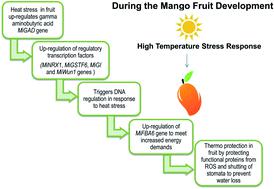Our official English website, www.x-mol.net, welcomes your feedback! (Note: you will need to create a separate account there.)
Adaptation mechanism of mango fruit (Mangifera indica L. cv. Chaunsa White) to heat suggest modulation in several metabolic pathways
RSC Advances ( IF 3.9 ) Pub Date : 2020-9-25 , DOI: 10.1039/d0ra01223h Zainab Khanum 1, 2 , Martín E Tiznado-Hernández 3 , Arslan Ali 1 , Syed Ghulam Musharraf 1, 2 , Muhammad Shakeel 1 , Ishtiaq Ahmad Khan 1
RSC Advances ( IF 3.9 ) Pub Date : 2020-9-25 , DOI: 10.1039/d0ra01223h Zainab Khanum 1, 2 , Martín E Tiznado-Hernández 3 , Arslan Ali 1 , Syed Ghulam Musharraf 1, 2 , Muhammad Shakeel 1 , Ishtiaq Ahmad Khan 1
Affiliation

|
Climate change is becoming a global problem because of its harmful effects on crop productivity. In this regard, it is crucial to carry out studies to determine crops' response to heatwave stress. Response molecular mechanisms during the development and ripening of mango fruit (Mangifera indica L. cv. Chaunsa White) under extreme heatwaves were studied. Mango flowers were tagged and fruits 18, 34, 62, 79, 92 days after flowering (DAF) as well as fruits on 10 and 15 days of postharvest shelf life were studied through RNA-Seq and metabolome of the fruit mesocarp. The environmental temperature was recorded during the experiment. Roughly, 2 000 000 clean reads were generated and assembled into 12 876 redundant transcripts and 2674 non-redundant transcripts. The expression of genes playing a role in oxidative stress, circadian rhythm, senescence, glycolysis, secondary metabolite biosynthesis, flavonoid biosynthesis and monoterpenoid biosynthesis was quantified as well as reactive oxygen species. Higher expressions of six abiotic stress genes and a senescent associated gene was found at 79 DAF (recorded temperature 44 °C). Higher expressions of nucleoredoxin and glutathione S-transferase 1 family protein were also recorded. Activation of the GABA-shunt pathway was detected by the glutamate decarboxylase transcript expression at 79 DAF. Larger energy demands at the beginning of fruit ripening were indicated by an increase in fructose-bisphosphate aldolase gene expression. Finally, the radical-scavenging effect of mango fruit inflorescence and fruit pulp extracts showed decline upon heatwave exposure. We recorded a broad genetic response of mango fruit suggesting the activation of several metabolic pathways which indicated the occurrence of genetic and metabolic crosstalks in response to intense heatwaves. Collectively, this study presents experimental evidence to help in the elucidation of the molecular mechanism of crops response to heat stress which in turn will help in the designing of protocols to increase crop productivity in the face of climate change.
中文翻译:

芒果果实(Mangifera indica L. cv. Chaunsa White)对热的适应机制表明对几种代谢途径的调节
气候变化正在成为一个全球性问题,因为它对作物生产力产生有害影响。在这方面,开展研究以确定作物对热浪胁迫的反应至关重要。研究了极端热浪下芒果果实(Mangifera indica L. cv. Chaunsa White)发育和成熟过程中的响应分子机制。对芒果花进行标记,并通过 RNA-Seq 和果实中果皮的代谢组对开花后 18、34、62、79、92 天 (DAF) 的果实以及采后保质期 10 和 15 天的果实进行研究。实验过程中记录环境温度。粗略地,生成了 2 000 000 个干净读取并组装成 12 876 个冗余转录本和 2674 个非冗余转录本。对在氧化应激、昼夜节律、衰老、糖酵解、次级代谢物生物合成、类黄酮生物合成和单萜生物合成以及活性氧中起作用的基因的表达进行了定量。在 79 DAF(记录温度 44 °C)下发现了六个非生物胁迫基因和一个衰老相关基因的较高表达。核氧还蛋白和谷胱甘肽S-转移酶 1 家族蛋白的表达也较高。通过 79 DAF 的谷氨酸脱羧酶转录物表达检测 GABA 分流途径的激活。果糖二磷酸醛缩酶基因表达的增加表明果实成熟初期需要更大的能量。最后,芒果果实花序和果肉提取物的自由基清除作用在热浪暴露后表现出下降。我们记录了芒果果实的广泛遗传反应,表明几种代谢途径的激活,这表明在应对强烈热浪时发生了遗传和代谢串扰。总的来说,这项研究提供了实验证据,有助于阐明作物对热应激反应的分子机制,这反过来又有助于设计应对气候变化时提高作物生产力的方案。
更新日期:2020-09-25
中文翻译:

芒果果实(Mangifera indica L. cv. Chaunsa White)对热的适应机制表明对几种代谢途径的调节
气候变化正在成为一个全球性问题,因为它对作物生产力产生有害影响。在这方面,开展研究以确定作物对热浪胁迫的反应至关重要。研究了极端热浪下芒果果实(Mangifera indica L. cv. Chaunsa White)发育和成熟过程中的响应分子机制。对芒果花进行标记,并通过 RNA-Seq 和果实中果皮的代谢组对开花后 18、34、62、79、92 天 (DAF) 的果实以及采后保质期 10 和 15 天的果实进行研究。实验过程中记录环境温度。粗略地,生成了 2 000 000 个干净读取并组装成 12 876 个冗余转录本和 2674 个非冗余转录本。对在氧化应激、昼夜节律、衰老、糖酵解、次级代谢物生物合成、类黄酮生物合成和单萜生物合成以及活性氧中起作用的基因的表达进行了定量。在 79 DAF(记录温度 44 °C)下发现了六个非生物胁迫基因和一个衰老相关基因的较高表达。核氧还蛋白和谷胱甘肽S-转移酶 1 家族蛋白的表达也较高。通过 79 DAF 的谷氨酸脱羧酶转录物表达检测 GABA 分流途径的激活。果糖二磷酸醛缩酶基因表达的增加表明果实成熟初期需要更大的能量。最后,芒果果实花序和果肉提取物的自由基清除作用在热浪暴露后表现出下降。我们记录了芒果果实的广泛遗传反应,表明几种代谢途径的激活,这表明在应对强烈热浪时发生了遗传和代谢串扰。总的来说,这项研究提供了实验证据,有助于阐明作物对热应激反应的分子机制,这反过来又有助于设计应对气候变化时提高作物生产力的方案。



























 京公网安备 11010802027423号
京公网安备 11010802027423号